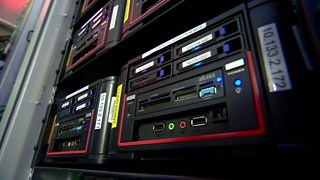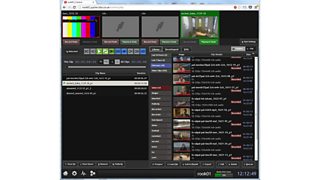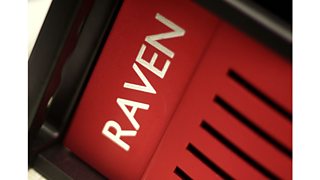Raven: File based ingest for �������� News
Michael Satterthwaite
Product&Installation Manager
Tagged with:
I’m Mike Satterthwaite and I’m product and installation manager for the Broadcast Systems Development Team.
We are one of the teams inside the �������� working on internal technology development. We normally develop products and solutions when there is nothing fit for purpose on the commercial market. This may involve integrating commercial products with internally developed ‘glue ware’.

Raven at Lund Point for HD Olympic broadcasts
As a department our philosophy is to develop everything as reusable components that can be dropped into multiple workflows to fulfil a host of different needs across the organisation.
We try to use where possible as we subscribe to the opening and fair-sharing of software and are always keen to save the �������� money. As a whole we gives back to the same community by funding contributions to those open source projects.
Our biggest ‘customers’ are and both in the UK and also the international news bureaus and our systems are installed across the globe.
One of the products we have been developing over the last few years is Raven.
The original specification for Raven was for a box that would replace a tape deck in news satellite vans allowing news crews to do file based ingest when they are out in the field.
The �������� and other broadcasters have been moving away from tape based delivery to file based working over the last few years and, in my opinion, it’s a much bigger challenge than the move to HD. This is because there are so many different elements which need to work in unity with existing and immovable systems and infrastructures.
As well as the software requirements there were also environmental factors such as the physical need to fit the box into the space left by the removed tape deck.
The box needed to be able to accept different card formats because although the �������� uses a that records on in the codec, other news producers will use different types of cameras, cards and codecs. Footage is often shared between camera crews in the field so the box needed to be able to read anything that was required.
Raven was developed as an application stack consisting of:
- A Javascript based web UI,utilising a variety of libraries including and .
- A utilising among other technologies , and .
- A series of small performing file system monitoring and job management.
- 'nuget', a C++ daemon utilising 's Decklink API to control baseband operations.
We put this on commodity hardware, things that anyone can go out and buy from the shops, so it’s effectively just a PC you could have at home with the addition of a baseband video interface card from Blackmagic Design.

The Raven interface
It runs on , a distribution of the operating system and makes a lot of use of for media manipulation.
�������� News were keen for the box to act like a tape deck so they could record video into it and also play video out of it onto a pre-existing infrastructure. As there were no longer any tapes Raven itself therefore needed to have some sort of storage element built in.
News also wanted the ability to take files off Raven and edit them quickly in the field then drop the piece back on the box and play it out directly.
It’s this kind of challenge which puts my team in their element because we were expected to develop a solution within a pre-existing problem space without changing anything else around it.
For example, as the satellite trucks were designed around baseband video i.e. real video voltages going down cables as opposed to IP, Raven had to bridge this gap.
After solving the initial problem the next step in the development of Raven was stimulated by the HD broadcast of the in April 2011. At this point it became obvious we would have to consider more storage to scale with the growing requirements.
How could we join several Raven boxes together and share between them? We started to look at different ways of approaching this and think about a structure beyond a single box.
We solved this issue by developing something called a Raven nest, which is essentially a group of Ravens with a core storage server called a Ravenstore. This allowed all Ravens to access the same material for both recording and play out as well as sharing with editors.
The next challenge for the Raven was the in 2012 where we experimented with media tagging.
This is when the clips or video being recorded are viewed and then given an appropriate associated label or ‘tag’. This tag then determines where the clips appear in a folder structure. So someone who’s sat in an edit suit or in front of a laptop in the field can look at a certain folder associated with that tag and edit only the relevant material.
Clips can have any number of tags but Raven doesn’t copy the recording multiple times. Instead by making use of the Linux operating system we are able to symlink the same file in multiple locations without taking up additional space.

Raven 3U
Undoubtedly the biggest challenge for Raven was the 2012 Olympics.
Nine months before the start of the Games we decided on a set of new features that Raven needed to deliver. However, the nature of news planning meant a lot of the final designs for the system were unknown until closer to the event. In some cases the workflows were changing literally the night before.
We installed eight Raven boxes in , where the �������� News headlines were broadcast, as well as centralised storage for all the prerecorded packages which were played out during News bulletins.
There was hardware control of each Raven box and individuals doing editing off that shared storage in .
This ultimately became the system that played out video live for the One, Six and Ten o’clock news in HD throughout the whole two weeks of the Olympics and didn’t drop a single frame of the one million it broadcast.
When you consider that two and a half years before this Raven was just an idea, to then be finding it driving the HD News bulletins of the Olympics is a significant achievement.
However, when you look at the level of requirements for News over the Olympics I don’t think there was another option. People had become so familiar with using Raven by this point and they expected a lot from the product and weren’t let down.
Ravens are now doing everything from recording audio for logging purposes to live playout in Singapore to being used for archive purposes and they are still used in every satellite vehicle the �������� owns.
There are now around 350 to 400 Ravens used around different parts of the ��������, all built by my department either in the original 3units size or the smaller Raven minis which most people now have. We also have some built around Hewlett Packard hardware.
You can fit two of the minis side by side on a 19 inch rack bay and it also means you can have one with a smaller tape deck next to it. The original, larger version is meant to be mounted on a rack and be a permanent installation unit.
Going back to our departmental philosophy Raven has a full API means that it has the capacity to be reused in multiple different ways by other areas of the ��������.
For example, in Northern Ireland they have written a BNCS driver to control the Raven through the same interface they previously used to remotely control a tape deck. BNCS, now called Colledia Control, is the broadcast network control system used by the �������� to drive a lot of our broadcast devices.
Raven continually has to adapt to the next change in the business workflow. You have to be able to adapt as the broadcast industry is constantly changing at an ever increasing rate.
It would be interesting to hear what you think about Raven and your experiences of the file based transition.
Michael Satterthwaite is product and installation manager for the Broadcast Systems Development Team.
